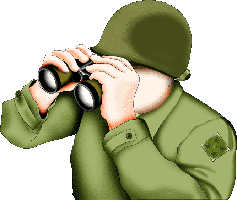The reasons for this kind of kit
building approach is simple!
First of all the 4th Infantry Division was a D-Day outfit and we may be
called upon to do that impression. Secondly, you can carry over
most
if not all of your Normandy kit through till the end of the war, its
not
necessarily the case the other way around.
Field Uniforms
-M1941 Jacket, with 4th Infantry Division patch on
left shoulder
-Enlisted Wool Overcoat, Mackinaw or Winter Combat Jacket (all
optional)
-Enlisted Wool Shirt (without epaulettes)
-Tan Wool Necktie (To be worn in the field for certain events)
-OD or White T-shirt
-Wool Field Trousers (light mustard shade preferred)
-Overseas Cap (No service piping is necessary) or Wool Jeep Cap
-G.I. Low Quarter Rough Out Service Shoes
-M1936 Dismounted Leggings (May be cut-downs, but contact your sergeant
first)
-•M1 Steel Helmet (Helmet web chinstrap should be sewn)
-•M1 helmet liner w/leather chinstrap (WWII liners generally have side
posts and a grommet in the front for insignia device)
-Khaki or Olive Web Trouser Belt w/ black open frame buckle
Alternate Uniforms (depending on scenario)
-M1943 Jacket
-M1943 Trousers
-HBT Jacket and Trousers
-Daisy Mae Hat
-M1943 Double-Buckle Boots,
-Shoepacks or Overshoes
Dress Uniforms
-Service Cap or Overseas Cap (No service piping is
necessary)
-Wool Shirt
-Tan Wool Necktie
-Wool Trousers
-4-Pocket Tunic
-Ike Jacket
-G.I. Toe Cap Service Shoes
Field Equipment
-M1910 or M1928 Haversack with Meat Can Pouch
(preferred)
-Meat Can (Mess Kit) & Utensils
-M1936 Pistol Belt (for those with a Carbine &/ or .45 Pistol)
-M1 carbine mag pouches
-M1923 "10-Pocket" Cartridge Belt (for use with Springfield or M1
Garand
Rifles)
-Canteen, Cup, & Carrier
-Carlisle Tin w/ Pouch
-M1910 T-Handle Shovel, M1943 Folding E-Tool, Pick mattock or Hatchet
with appropriate carriers
-M1936 Musette Bag with general purpose strap
-M1936 Suspenders
-Bedroll (Wool blanket/s or sleeping bag)
-Shelter Half Pup Tent (2 halves must have buttons as opposed to snaps)
-Personal Articles (Shaving kit, Playing Cards, etc.).
Weapons
-M1 Garand Rifle, Leather or Web Sling (preferred)
-M1 Carbine (without bayonet lug)
-M1903A3 Springfield Rifle, Leather Sling
-M1 or M1A1 Thompson Submachine gun
-M3 or M3A1 Greasegun Submachine gun
-M1911 or M1911A1 Semi-Auto .45 Pistol (to be carried by NCO's and
officers only)
-Appropriate Bayonet for Springfield Rifles
-M3 Knife (if you are carrying a carbine)
-Browning Automatic Weapon (BAR)
•M1 Helmet Appearance
In the 4th ID I&R Platoon the headgear of choice is the
old M1 steel
pot. Prior to the Normandy landings soldiers often painted the
divisional
“Ivy” emblem onto their helmets, but this appears to have been
something
done individually and not ordered by the divisional commander Raymond
Barton.
Below are a series of examples of painted and unpainted 4th ID pots.
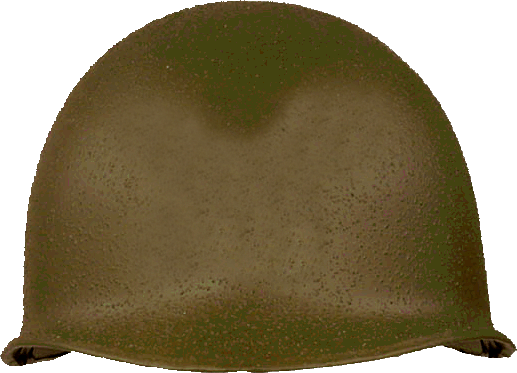

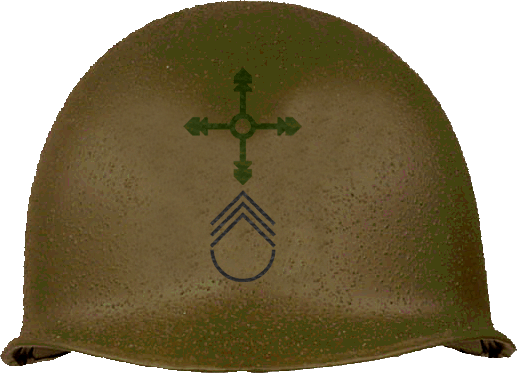
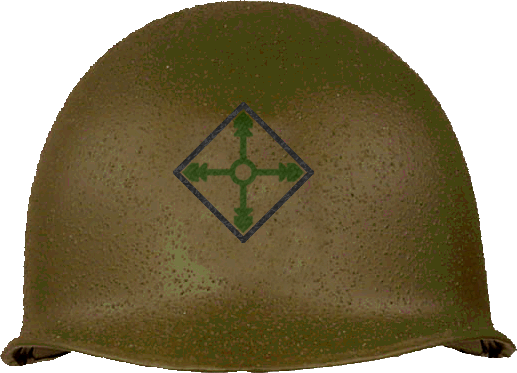
Helmet netting can be added to the pot (both large and small
aperture
netting), especially whenever in the portrayal of the 4th Infantry
Division
during the Normandy campaign. In fact assault Platoons often were
issue scrim (dyed burlap strips) to weave within thier helmet netting
to
help break up their silhouettes in combat.
Dress Guidelines
"All work and no play makes the
I&R go away!"
Minimum dress uniform for social affairs:
1. EM wool trouser
2. EM wool shirt w/4th ID patch affixed
3. Overseas garrison cap
4. Open face khaki web belt
5. Khaki twill necktie
6. Leggings
7. Garrison boots.
Personnel of the 4th ID, 8th Regt. I&R platoon are
encouraged to
purchase a Class A uniform, which is the preferred dress uniform for
social
affairs such as USO and O Club dances. The Class A’s are a
step above the wool shirt and trousers and are where you can wear your
unit insignias, citations, and rank. These should be placed upon
your uniform in the correct manner according to your FM 21-100.
What items can be worn:
1. Collar Disks
2. Your rank.
3. Distinguished Insignia (8th Inf. Regt. DI)
4. Qualification Badges (matched to the weapons you have explicit
knowledge about)
5. Overseas service stripes
6. Time in service stripes
7. Good conduct ribbon
8. CIB (Combat Infantryman’s Badge)
1. •Citations for valor (i.e. Purple Hearts, Bronze
& Silver
Stars, CMH’s, etc...)
Best judgement and historical consideration.
1. French Fourragere (generally worn post war)
2. Presidential Unit Citation (generally worn post war)
•The exception to this rule is when an individual has earned
these citations
during their active or reserve service to our country.
Rank Structure & Policy regarding ranks
In reenactment rank is often a matter of debate. In
the military
there is no debate, you earn your rank & grade. Rank
correlates
to pay and responsibility, in reenactment it correlates to a $5 patch
that's
all. In the 4th Infantry Division Intelligence &
Reconnaissance
Platoon rank is directly equivalent to troop numbers and troop
responsibilities.
All squad elements are led by Sergeant, corporals fill support roles
such
as RTO's, Drivers, etc... and serve as assistant squad leaders.
When
the troop reaches a strength of 10 men the tenured sergeant will be
elevated
to the rank of Staff Sergeant and once troop strength has reached 25
men,
a 1st. Lt. will be assigned to lead the troop and the Staff Sergeant
will
become Platoon Sergeant.
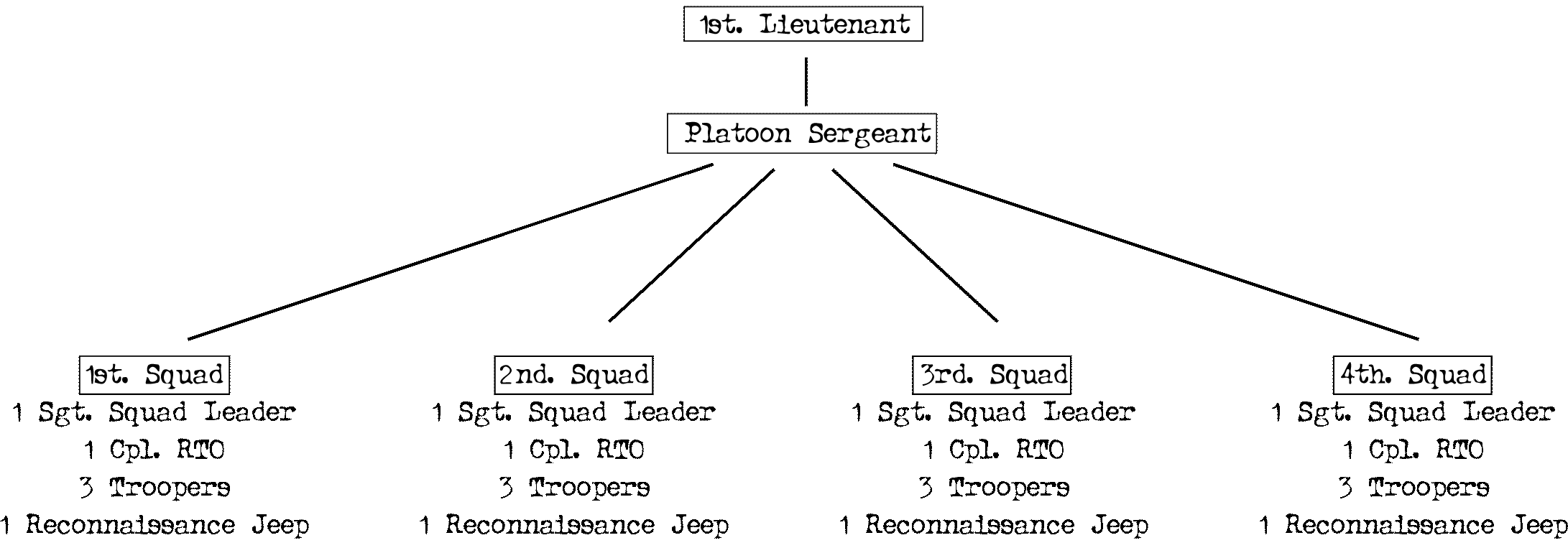
Vehicles of the 4th Infantry Division, 8th.
Regiment's
I&R Platoon
VEHICLES:
The 4th Infantry Division 8th. Regt. Intelligence &
Reconnaissance
Platoon is strictly assigned to jeeps as were most I&R Platoons in
the ETO. All participating I&R vehicles must be vintage WWII
dated Willys MB or Ford GPW jeeps. Professional post war jeep
conversions,
where their is visually nothing different in the external appearance
from
war dated jeeps are acceptable as well, but the restoration must be a
clean
conversion.
WEAPONRY:
I&R jeeps are unique as they’re generally heavily armed
with a M2
.50 cal. HMG affixed to a pedestal mount just behind and between the
driver
and front passenger’s seat. Ammunition was carried inside the
vehicle
in addition to a bustle basket often affixed to the rear body
panel.
RADIO:
I&R Jeeps often carried a radio to report back to
regiment their
findings. The jeep radio of choice was the SCR-694, which fit on
the left rear wheel well just behind the driver, this allowed the right
well to be used for transportation of personnel as well as freeing up
the
rear passenger seat. The SCR-694 was both portable and vehicular,
successor to SCR-284 to whose crystal control it added two preset
frequencies.
Its favor used alone laws SCR-714. A late and improved version with
continuous-wave
range up to 75 miles was AN/GRC-9.

BUMPER MARKING
The following markings should be used on 4th ID, 8th. Regt.
I&R
jeeps (the only variable number is the one next to "HQ", which is the
number
vehicle in the regimental motorpool. The number "12" has been
used
merely as an example.)
*Top is the front bumper and bottom are the
bumperettes.

USE OF VEHICLES IN REENACTMENT:
The 4th Infantry Division 8th. Regt. Intelligence &
Reconnaissance
Platoon recognizes that 1/4 ton vehicles bearing large caliber weapons
are no substitute for armor. No soldier during WWII would ever
drive
a jeep down the throat of a Tiger I tank, at least not one in his right
mind. The I&R jeep was meant to dispatch its personnel deep
inside
enemy territory, be cached until the I&R team needed to be
extricated.
The M2 .50 cal HMG was meant to buy time should the I&R team be
discovered
in the process of gathering intelligence, not to engage the enemy
unless
the target availed itself as one of opportunity.
Jeeps within the 4th ID 8th. Regt. I&R living history
Pltn. are
to be used primarily as a troop transport to a designated point of
deployment
on foot of the I&R squad, whereupon the vehicle will be cached and
concealed with appropriate camouflage. Our vehicles are also to
be
used for field emergencies during reenactment events, should the event
organizers need them for such duty.

